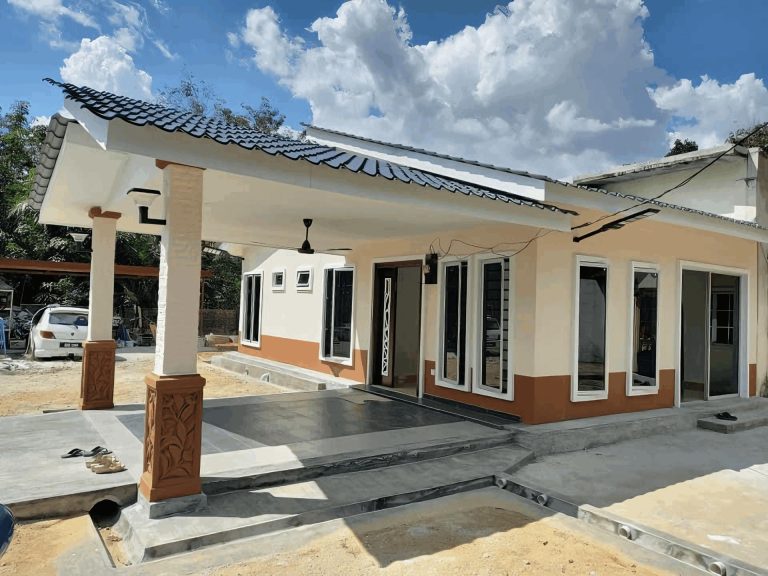Are you ready to dive into the world of construction with us? Whether you’re a seasoned contractor or just dipping your toes into the building game, one thing’s for sure: cost estimating can be a total minefield. Sure, it sounds straightforward – you jot down some numbers and hope for the best. But let’s be real: one tiny miscalculation can lead to a financial mess that keeps you tossing and turning at night! In Malaysia, where projects can span from stunning skyscrapers to cozy kampung homes, getting your estimates right is crucial. Join us as we unpack eight common cost estimating blunders that can turn your construction dreams into haunting nightmares. Ready to pit your wits against the pitfalls? Let’s go!
Understanding the Impact of Inaccurate Quantity Takeoffs
In the world of construction, quantity takeoffs are the backbone of accurate cost estimating. When these calculations go awry, the repercussions can ripple through the entire project, impacting not just budgets but schedules too. An inaccurate estimate can lead to a chain reaction of issues, from over-ordering materials to significant delays in project timelines. Picture this: a project starting on the right foot but quickly losing steam because of mismatched quantities. That’s a nightmare every project manager dreads!
One of the critical areas affected by inaccurate takeoffs is cash flow management. With unexpected costs popping up like uninvited guests, it becomes nearly impossible to stick to a budget. This may result in decisions like cutting corners or rushing to complete work just to stay on track financially, which can compromise quality. And let’s not forget the emotional toll on the team—stress levels can skyrocket when everyone scrambles to correct mistakes that could’ve been avoided with a solid takeoff plan.
Moreover, embedding inaccuracies into pre-construction plans can tarnish your reputation. Clients expect meticulous attention to detail, and when you fall short, it can jeopardize future opportunities. Building trust is crucial, and a few slip-ups on quantity takeoffs can leave clients wary, questioning your reliability. Here’s a quick rundown of the potential fallout:
| Impact | Consequences |
|---|---|
| Budget Overruns | Increased project costs, potential loss of profit |
| Delayed Timelines | Rescheduling issues, project bottlenecks |
| Compromised Quality | Client dissatisfaction, risk of rework |
| Damaged Reputation | Loss of future contracts, diminished trust |

Overlooking Contingency Budgets and Their Consequences
In the hustle and bustle of the construction world, it’s easy to underestimate the importance of contingency budgets. Many project managers and teams overlook this fundamental aspect, thinking it’s just a safety net that isn’t worth the extra cost. However, not setting aside funds for unexpected events can lead to a financial downfall. As costs spiral from unanticipated delays or price hikes in materials, the absence of a contingency budget can cause serious strain on a project’s finances, pushing companies into a tight spot.
Think about it: every construction project comes laden with uncertainties. Weather changes, supply chain issues, and even sudden regulatory modifications can throw a wrench in your plans. Without a flexible budget, these factors can exacerbate costs, making it nearly impossible to deliver a project on time and within the original budget. When worst-case scenarios occur and there’s no buffer to lean on, teams often scramble to cover expenses, which can lead to lower quality work, missed deadlines, and strained client relationships.
A well-thought-out contingency budget can serve as a lifeline, allowing teams to navigate the turbulence of unforeseen challenges with more confidence. To illustrate this importance, consider the following factors that can benefit from such a budget:
| Factor | Benefit of Contingency Budget |
|---|---|
| Project Delays | Funds for overtime or expedited shipping. |
| Material Price Changes | Ability to procure necessary materials without delays. |
| Regulatory Changes | Adjustment funds for compliance costs. |

Neglecting Historical Data in Cost Predictions
When it comes to estimating costs in construction, ignoring what happened in the past can lead to some serious headaches. Historical data is like a treasure map; it gives you insights into potential expenses, trends, and even obstacles you might encounter along the way. By overlooking these valuable lessons, you might find yourself underestimating costs, which can derail your entire project and leave you scrambling to find extra funds.
Many builders and contractors often think basing their predictions on current market conditions is enough. However, without the context of historical data, it’s easy to fall into common traps. For instance, one might err in thinking the price of materials will continue in a favorable direction without considering past spikes or slumps. This oversight can result in substantial discrepancies between expected and actual costs, causing unforeseen project delays.
Using past data not only helps in making more accurate predictions but also aids in identifying patterns. For example, if certain materials consistently increase in price during specific seasons, that’s crucial information for budgeting. Here’s a quick overview of the impact of neglecting to consider historical data:
| Consequence | Impact |
|---|---|
| Unreliable Budgeting | Costs skyrocket as estimates become unrealistic. |
| Project Delays | Funding shortages lead to halted work. |
| Loss of Client Trust | Reputation takes a hit due to financial mismanagement. |
relying solely on current factors without considering historical data might seem like a shortcut, but it’s a road paved with pitfalls. Embracing a thorough analysis of past projects can not only streamline your cost estimations but also make you a more reliable player in the construction game. Why gamble on past mistakes when you can learn from them?

Ignoring the Role of Market Fluctuations
When crafting your construction budget, it’s tempting to base it solely on previous projects or fixed estimates. However, failing to account for market fluctuations can lead to shockingly inaccurate projections. The construction landscape is far from static; prices for materials, labor, and equipment can swing dramatically based on economic conditions, seasonal influences, or even geopolitical events. Without factoring in these changes, you risk both overestimating and underestimating costs, which can lead to severe financial repercussions later on.
To steer clear of this common pitfall, consider staying updated on key market indicators. Here are some essential tracking elements:
- Global commodity prices – Keep an eye on price changes in raw materials like steel and concrete.
- Local labor rates – Monitor shifts in labor costs influenced by demand and skill availability in your area.
- Economic forecasts – Pay attention to reports on the overall economy that might signal a change in construction spending.
Integrating a flexible price adjustment mechanism is crucial. By establishing contingencies in your budget—say, an additional 10% for materials—you’re better equipped to handle unexpected hikes. You might also want to create an ongoing dialogue with suppliers to lock in favorable rates or explore bulk purchasing options to hedge against future price spikes. It’s all about building a strategy that allows your budget to breathe and adapt, ensuring that your construction dreams don’t morph into financial nightmares.

Misestimating Labor Costs and Their True Implications
One of the most common pitfalls in construction cost estimating is simply miscalculating labor costs. It’s easy to assume you know how long a task will take based on previous experience or a gut feeling, but this can be a dangerously flawed approach. Construction projects often face unpredictable circumstances like inclement weather, equipment malfunction, or unexpected site conditions that can still prolong the timeframe. When you underestimate the time and effort required, you’re setting yourself up for cost overruns that can derail your entire budget.
Consider the cost implications of misestimating labor:
- Delayed project timelines: Overlooked labor hours can lead to extended schedules, inflating costs further with penalties or increased wage rates.
- Employee morale: When workers are pressured to rush to finish projects, it can affect their performance and lead to accidents, resulting in increase in workforce compensation claims.
- Resource allocation errors: Misjudging labor needs can lead to inefficiencies, as crews may be either overstaffed or understaffed, causing frustration and decreased productivity on-site.
To illustrate how significant these implications can be, check out the table below:
| Scenario | Estimated Cost | Potential Overrun |
|---|---|---|
| Labor underestimation leading to delays | RM 500,000 | RM 150,000 |
| Safety incidents from rushed work | RM 300,000 | RM 100,000 |
| Overstaffing due to miscalculation | RM 200,000 | RM 50,000 |

Failing to Communicate with the Project Team Effectively
Effective communication doesn’t just make the project run smoothly; it acts as the glue binding the team together. When lines of communication are unclear or absent, issues tend to snowball, leading to enormous setbacks. Team members may misinterpret tasks, deadlines may be missed, and valuable resources might be wasted. Everyone must be on the same page, yet the chaos that ensues from a lack of clarity is a mistake many project teams fall prey to, ultimately weighing down the overall success.
Imagine a scenario where one team member thinks a design is finalized, while another is still working on revisions. Parameters change, deadlines fluctuate, and outputs vary, leaving room for frustration. Gathering the team for regular catch-ups, setting clear expectations, and ensuring everyone has access to necessary documents can prevent these misunderstandings. Overcommunication isn’t a bad thing; in fact, it can help create a cohesive environment where everyone feels empowered to share updates and voice concerns freely.
Plus, let’s not forget about the technology we have at our fingertips. Utilizing collaborative tools can significantly enhance how your project team communicates. Quick messaging platforms, shared calendars, and project management software streamline communication and detail sharing. Whenever changes occur, having a platform where everyone can instantly access updates minimizes confusion and boosts accountability. So, invest in these tools, and you’ll avoid the pitfalls of poorly executed communication that follow you like a shadow through your project lifecycle.

Underestimating the Need for Risk Management Strategies
When it comes to construction projects, skipping out on robust risk management strategies can lead to catastrophic consequences. Many project managers feel confident in their ability to navigate challenges as they arise, but this can be a dangerous assumption. The reality is that unforeseeable events, such as supply chain disruptions, weather issues, or even regulatory changes, can quickly derail a project. Without a proper risk management framework, you’re essentially flying blind, exposing yourself to unnecessary potential losses.
Effective risk management isn’t just about identifying potential issues; it’s about creating a proactive plan that addresses them head-on. This means conducting thorough risk assessments and establishing clear protocols for mitigation. Consider implementing strategies like:
- Regular communication with team members and stakeholders.
- Contingency budgeting to accommodate unexpected costs.
- Documenting lessons learned from past projects to avoid repeating mistakes.
Moreover, the absence of a structured risk management approach often leads to confusion and miscommunication among the workforce. Keeping everyone in the loop is essential, and utilizing tools like risk matrices can help visualize where the most significant threats might lie. Here’s a simple table demonstrating how potential risks can range from low to high impact:
| Risk Factor | Probability | Impact |
|---|---|---|
| Delays in material delivery | Medium | High |
| Labor shortages | High | Medium |
| Regulatory changes | Low | High |

Regular Reviews and Adjustments: A Key to Accurate Estimating
In the fast-paced world of construction, sticking to a plan without revisiting it can lead to major miscalculations. Regularly setting aside time to review and adjust your estimates can help to align project expectations with actual progress. Ignoring this crucial step can lead to scenarios where costs spiral out of control, leaving you with the bill at the end. By implementing a routine check-in process, you can catch discrepancies early on, ensuring that your calculations stay sharp and relevant.
During these assessment sessions, consider focusing on the following areas:
- Materials: Are the prices still in line with market trends?
- Labour Costs: Have there been changes in overtime rates or skilled labour availability?
- Project Timeline: Is the schedule still feasible or are there delays that might affect costs?
A well-structured process for reviews can streamline your estimating. Here’s a simple table to help you visually assess adjustments:
| Review Date | Focus Area | Findings | Adjustments Made |
|---|---|---|---|
| 01/01/2023 | Materials | Price increase noted on steel | Increased budget by 10% |
| 01/03/2023 | Labour Costs | New certification required for workers | Adjusted labor costs by 5% |
Staying vigilant through regular evaluations not only enhances your estimating precision but also builds a robust foundation for project management. When team members see the commitment to accuracy and transparency in cost management, it fosters a culture where everyone is aligned. In the long run, this diligence pays off, preventing cost overruns and ensuring project success.
To Wrap It Up
And there you have it – eight cost estimating blunders that can easily turn your construction dreams into a living nightmare. It’s all too easy to overlook the fine details or get overly optimistic about costs, but as we’ve seen, those missteps can really add up.
Whether you’re a seasoned contractor or just dipping your toes into the construction world, it’s crucial to pay attention and learn from these common pitfalls. Remember, every ringgit counts! So the next time you gear up for a new project, take a moment to reflect and strategize.
No one wants those sleepless nights plagued by budget chaos, right? With a bit of diligence and the right approach, you can steer clear of these blunders and keep your projects on track. Here’s to smooth sailing in your next construction venture – may your estimates be accurate, and your projects be successful! Happy building, Malaysia!








